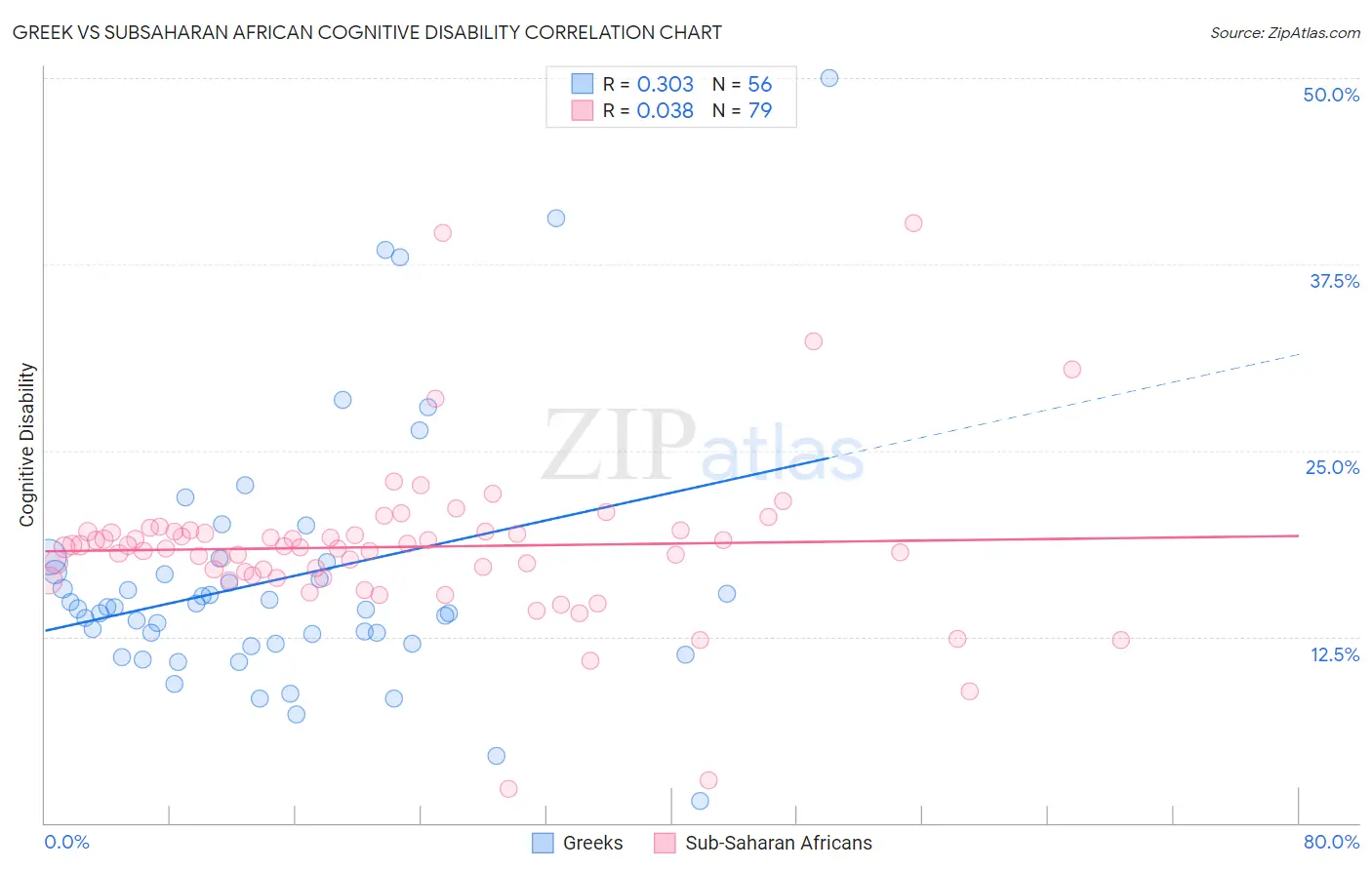Greek vs Subsaharan African Cognitive Disability
COMPARE
Greek
Subsaharan African
Cognitive Disability
Cognitive Disability Comparison
Greeks
Sub-Saharan Africans
16.4%
COGNITIVE DISABILITY
99.9/ 100
METRIC RATING
36th/ 347
METRIC RANK
18.5%
COGNITIVE DISABILITY
0.0/ 100
METRIC RATING
314th/ 347
METRIC RANK
Greek vs Subsaharan African Cognitive Disability Correlation Chart
The statistical analysis conducted on geographies consisting of 482,712,046 people shows a mild positive correlation between the proportion of Greeks and percentage of population with cognitive disability in the United States with a correlation coefficient (R) of 0.303 and weighted average of 16.4%. Similarly, the statistical analysis conducted on geographies consisting of 508,099,215 people shows no correlation between the proportion of Sub-Saharan Africans and percentage of population with cognitive disability in the United States with a correlation coefficient (R) of 0.038 and weighted average of 18.5%, a difference of 12.8%.

Cognitive Disability Correlation Summary
| Measurement | Greek | Subsaharan African |
| Minimum | 1.5% | 2.3% |
| Maximum | 50.0% | 40.3% |
| Range | 48.5% | 38.0% |
| Mean | 16.4% | 18.5% |
| Median | 14.4% | 18.5% |
| Interquartile 25% (IQ1) | 12.0% | 16.6% |
| Interquartile 75% (IQ3) | 17.2% | 19.6% |
| Interquartile Range (IQR) | 5.2% | 2.9% |
| Standard Deviation (Sample) | 8.7% | 5.5% |
| Standard Deviation (Population) | 8.6% | 5.5% |
Similar Demographics by Cognitive Disability
Demographics Similar to Greeks by Cognitive Disability
In terms of cognitive disability, the demographic groups most similar to Greeks are Slovak (16.4%, a difference of 0.010%), Italian (16.4%, a difference of 0.090%), Russian (16.4%, a difference of 0.090%), Slovene (16.5%, a difference of 0.15%), and Immigrants from Israel (16.4%, a difference of 0.16%).
| Demographics | Rating | Rank | Cognitive Disability |
| Filipinos | 99.9 /100 | #29 | Exceptional 16.4% |
| Czechs | 99.9 /100 | #30 | Exceptional 16.4% |
| Immigrants | Romania | 99.9 /100 | #31 | Exceptional 16.4% |
| Immigrants | Israel | 99.9 /100 | #32 | Exceptional 16.4% |
| Italians | 99.9 /100 | #33 | Exceptional 16.4% |
| Russians | 99.9 /100 | #34 | Exceptional 16.4% |
| Slovaks | 99.9 /100 | #35 | Exceptional 16.4% |
| Greeks | 99.9 /100 | #36 | Exceptional 16.4% |
| Slovenes | 99.9 /100 | #37 | Exceptional 16.5% |
| Immigrants | Eastern Europe | 99.9 /100 | #38 | Exceptional 16.5% |
| Bolivians | 99.9 /100 | #39 | Exceptional 16.5% |
| Immigrants | Belarus | 99.9 /100 | #40 | Exceptional 16.5% |
| Cubans | 99.9 /100 | #41 | Exceptional 16.5% |
| Hungarians | 99.9 /100 | #42 | Exceptional 16.5% |
| Immigrants | Canada | 99.8 /100 | #43 | Exceptional 16.5% |
Demographics Similar to Sub-Saharan Africans by Cognitive Disability
In terms of cognitive disability, the demographic groups most similar to Sub-Saharan Africans are Yaqui (18.5%, a difference of 0.060%), Chickasaw (18.5%, a difference of 0.17%), Immigrants from Dominica (18.6%, a difference of 0.18%), Immigrants from Middle Africa (18.6%, a difference of 0.26%), and Liberian (18.6%, a difference of 0.34%).
| Demographics | Rating | Rank | Cognitive Disability |
| Ugandans | 0.0 /100 | #307 | Tragic 18.3% |
| Immigrants | Western Africa | 0.0 /100 | #308 | Tragic 18.4% |
| Immigrants | Eastern Africa | 0.0 /100 | #309 | Tragic 18.4% |
| Choctaw | 0.0 /100 | #310 | Tragic 18.4% |
| Hmong | 0.0 /100 | #311 | Tragic 18.4% |
| Chickasaw | 0.0 /100 | #312 | Tragic 18.5% |
| Yaqui | 0.0 /100 | #313 | Tragic 18.5% |
| Sub-Saharan Africans | 0.0 /100 | #314 | Tragic 18.5% |
| Immigrants | Dominica | 0.0 /100 | #315 | Tragic 18.6% |
| Immigrants | Middle Africa | 0.0 /100 | #316 | Tragic 18.6% |
| Liberians | 0.0 /100 | #317 | Tragic 18.6% |
| Bangladeshis | 0.0 /100 | #318 | Tragic 18.6% |
| Comanche | 0.0 /100 | #319 | Tragic 18.6% |
| Apache | 0.0 /100 | #320 | Tragic 18.6% |
| Africans | 0.0 /100 | #321 | Tragic 18.6% |